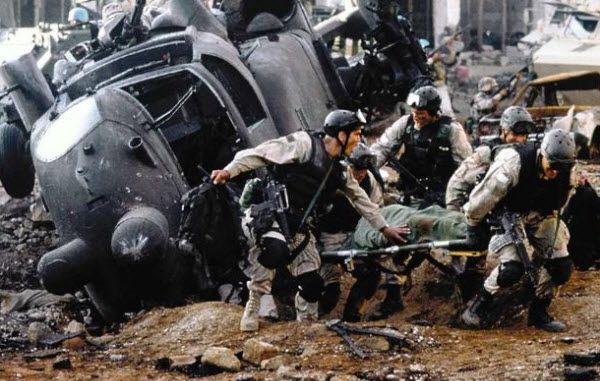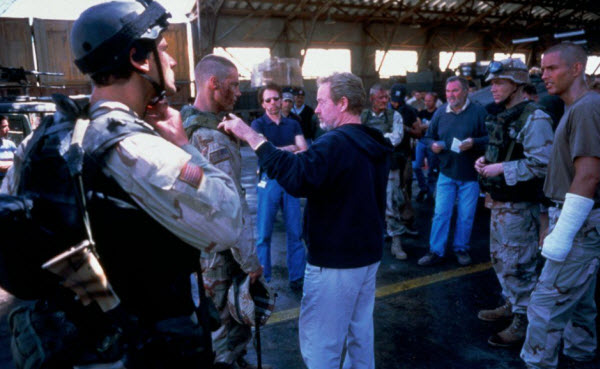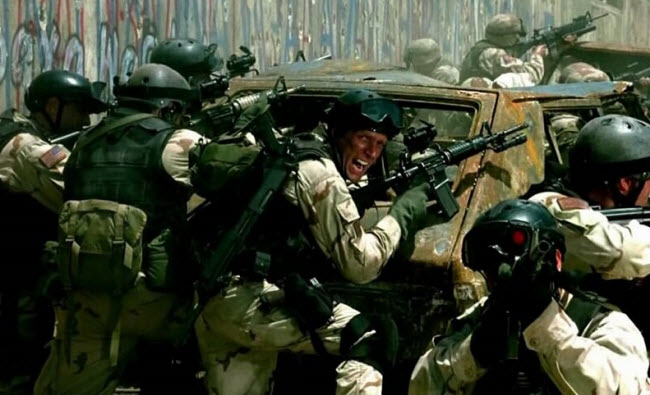“Black Hawk Down” is a powerful and intense portrayal of modern warfare, directed by Ridley Scott. Released in 2001, this film depicts the harrowing events of the Battle of Mogadishu, a U.S. military mission gone wrong in Somalia. Known for its unflinching realism, intricate storytelling, and gripping action sequences, “Black Hawk Down” has earned acclaim for its portrayal of bravery, sacrifice, and the chaotic nature of combat.
Plot Summary (Warning: Spoilers Ahead)

The film begins with a mission to capture a Somali warlord, Mohamed Farrah Aidid, in the chaotic streets of Mogadishu. The operation, initially deemed straightforward, quickly deteriorates as U.S. Army Rangers and Delta Force operators encounter fierce resistance. The situation escalates when two Black Hawk helicopters are shot down, leading to a desperate and prolonged battle for survival.
The narrative unfolds through the perspectives of various soldiers involved in the mission. As the troops are trapped and surrounded by hostile forces, they must fight to rescue their comrades and secure the crash sites of the downed helicopters. The film highlights the personal stories of the soldiers, their camaraderie, and their relentless struggle against overwhelming odds.
The battle rages through the night, with soldiers making heroic efforts to evacuate the wounded and retrieve the fallen. The film concludes with a somber reflection on the high cost of the mission, the heavy casualties, and the personal toll on the soldiers and their families.
Main Characters and Actors
Josh Hartnett (Staff Sergeant Matt Eversmann): The dedicated Army Ranger who becomes a central figure in the fight for survival during the battle.
Ewan McGregor (Specialist John “Grimesy” Grimes): The embedded journalist whose perspective provides additional depth to the soldiers’ experiences.
Tom Sizemore (Sergeant First Class Randy Shughart): The Delta Force sniper who demonstrates extraordinary bravery and sacrifice during the rescue operation.
Eric Bana (Captain Mike Steele): The leader of the extraction team who faces immense challenges and danger as he coordinates the rescue efforts.
William Fichtner (Lieutenant Colonel Danny McKnight): The experienced officer who provides critical support and leadership throughout the intense combat.
Orlando Bloom (Private First Class Todd Blackburn): A young soldier whose experiences reflect the harsh realities of modern warfare.
Awards and Recognition
“Black Hawk Down” received critical acclaim for its intense action and realistic portrayal of the Battle of Mogadishu. The film garnered several awards and nominations, including:
- Academy Award for Best Film Editing (2002): The film won this award for its immersive and impactful editing.
- Academy Award for Best Sound (2002): The film’s sound design was praised for its authenticity and contribution to the combat scenes.
- BAFTA Award for Best Editing (2002): The film’s editing was recognized by the British Academy of Film and Television Arts.
- Screen Actors Guild Award for Outstanding Performance by a Stunt Ensemble in a Motion Picture (2002): The film’s stunt work was acknowledged for its realism and execution.
Trivia (100 Interesting Facts)

- Real-Life Inspiration: The film is based on the real Battle of Mogadishu that took place on October 3-4, 1993.
- Filming Location: Much of the film was shot in Morocco, which was used to represent the streets of Mogadishu.
- Military Consultants: Real-life veterans of the battle served as consultants to ensure authenticity in the film’s depiction of combat.
- Helicopter Replicas: Replica Black Hawk helicopters were used for many of the film’s aerial combat scenes.
- Rigorous Training: The actors underwent military training to accurately portray their roles as soldiers.
- Josh Hartnett’s Role: Hartnett’s character, Staff Sergeant Matt Eversmann, was inspired by the real-life soldier of the same name.
- Ewan McGregor’s Role: McGregor played a journalist embedded with the soldiers, reflecting the presence of media during the actual battle.
- Tom Sizemore’s Bravery: Sizemore’s portrayal of Sergeant First Class Randy Shughart was based on the real-life heroism of the soldier.
- Eric Bana’s Performance: Bana’s character, Captain Mike Steele, was a composite of several real-life military leaders.
- William Fichtner’s Role: Fichtner’s portrayal of Lieutenant Colonel Danny McKnight added depth to the film’s depiction of military leadership.
- Orlando Bloom’s Debut: Bloom’s role as Private First Class Todd Blackburn was one of his early film appearances.
- Combat Realism: The film is praised for its realistic portrayal of urban warfare and the chaos of battle.
- Editing Style: The film’s editing was designed to immerse viewers in the intensity and confusion of the combat scenes.
- Sound Design: The sound design, including realistic combat sounds, was a key element in creating an authentic experience.
- Practical Effects: Some explosions and combat scenes were created using practical effects for added realism.
- Special Effects: The film used a combination of practical effects and CGI to depict helicopter crashes and intense combat.
- Famous Quote: The film features the quote, “It’s a hell of a thing to be outnumbered,” reflecting the soldiers’ dire situation.
- Music Score: Hans Zimmer’s score for the film added to its emotional and dramatic impact.
- Real Soldiers’ Involvement: Several real-life soldiers from the Battle of Mogadishu attended the film’s premiere.
- Director’s Vision: Ridley Scott’s vision for the film was to capture the battle’s chaos and the soldiers’ bravery authentically.
- Stunt Work: The film’s stunt work was recognized for its authenticity and execution, contributing to the film’s acclaim.
- Critical Reviews: The film received praise from critics for its intense action sequences and realistic depiction of battle.
- Box Office Success: The film grossed over $172 million worldwide, demonstrating its commercial success.
- Military Protocol: The film adhered to military protocols and procedures to ensure authenticity in its portrayal of combat.
- Cameo Appearances: Some extras in the film were actual military veterans from the Battle of Mogadishu.
- Emotional Impact: The film’s portrayal of the soldiers’ experiences added emotional depth to the combat scenes.
- Historical Context: The film provides historical context for the U.S. military’s involvement in Somalia during the 1990s.
- Authentic Costumes: The film’s costumes were designed to reflect the military gear used during the Battle of Mogadishu.
- Real Weapons: Real military weapons were used in the film to enhance realism.
- Documentary Influence: The film’s style was influenced by documentary filmmaking techniques to capture the chaos of battle.
- Real Helicopters: Some of the aerial sequences used real Black Hawk helicopters.
- Cameo Roles: Real soldiers from the battle made cameo appearances in the film.
- Battlefield Chaos: The film’s depiction of battlefield chaos was achieved through meticulous planning and execution.
- Director’s Challenges: Ridley Scott faced challenges in portraying the complexity and chaos of modern warfare.
- Military Accuracy: The film’s depiction of military tactics and equipment was praised for its accuracy.
- Authentic Depiction: The film’s portrayal of the Battle of Mogadishu was considered one of the most authentic in modern cinema.
- Visual Effects: The film used visual effects to enhance the realism of the combat scenes.
- Real Emotions: Many of the actors’ emotions in the film were real, reflecting the intense atmosphere on set.
- Method Acting: Some actors employed method acting techniques to fully immerse themselves in their roles.
- Military Precision: The film’s attention to military precision and detail added to its realism.
- Real Explosions: The explosions in the film were created using practical effects for greater impact.
- Character Development: The film’s characters are well-developed, adding depth to the narrative.
- Historical Research: The filmmakers conducted extensive research on the Battle of Mogadishu to ensure historical accuracy.
- Casting Choices: The film’s casting was carefully chosen to reflect the real-life soldiers’ experiences.
- Filmmaking Techniques: Ridley Scott’s use of filmmaking techniques, such as handheld cameras, added to the film’s realism.
- Critical Acclaim: The film received acclaim for its intense action and realistic portrayal of combat.
- Box Office Gross: The film’s box office gross demonstrated its commercial success and widespread appeal.
- Special Effects Team: The special effects team worked extensively to create realistic explosions and combat sequences.
- Military Protocols: The film adhered to military protocols and procedures to ensure accuracy.
- Realistic Combat: The film’s combat scenes were designed to reflect real-life military tactics and experiences.
- Stunt Coordination: The stunt coordination was highly praised for its realism and execution.
- Director’s Style: Ridley Scott’s directing style is evident throughout the film, with a focus on realism and intensity.
- Authentic Portrayals: The portrayals of soldiers and military operations were authentic and respectful.
- Visual Storytelling: The film’s visual storytelling is complemented by its strong narrative.
- Emotional Depth: The film’s emotional depth is heightened by its realistic depiction of combat and personal sacrifice.
- Critical Reception: The film was critically acclaimed for its intense action and realistic portrayal of battle.
- Accurate Depiction: The film’s depiction of the Battle of Mogadishu was accurate and detailed.
- Production Design: The film’s production design reflected the gritty reality of urban warfare.
- Character Interactions: The interactions between characters added depth to the film’s narrative.
- Historical Context: The film provides historical context for the events depicted, enhancing its educational value.
- Cinematic Techniques: The film’s use of cinematic techniques, such as cross-cutting, enhances the storytelling.
- Acting Ensemble: The film’s acting ensemble is one of its strongest aspects, with each actor delivering a memorable performance.
- Realistic Sound: The film’s sound design adds to the realism and intensity of the combat scenes.
- Military Accuracy: The film’s accuracy in depicting military tactics and operations was widely praised.
- Stunt Work: The film’s stunt work was executed with precision and attention to detail.
- Emotional Impact: The film’s emotional impact is heightened by its realistic portrayal of the battle and its consequences.
- Director’s Vision: Ridley Scott’s vision for the film was to create an immersive and realistic portrayal of modern warfare.
- Critical Acclaim: The film received acclaim from critics for its intense and realistic depiction of combat.
- Historical Accuracy: The film’s attention to historical accuracy adds to its credibility and impact.
- Character Development: The film’s characters are well-developed, adding depth to the narrative.
- Production Value: The film’s production value is high, with attention to detail in costumes, props, and set design.
- Realistic Depiction: The film’s depiction of the Battle of Mogadishu is considered one of the most realistic in modern cinema.
- Visual Impact: The film’s visual impact is enhanced by its realistic portrayal of combat and urban warfare.
- Soundtrack: Hans Zimmer’s soundtrack adds emotional depth and intensity to the film.
- Filmmaking Techniques: The film’s use of filmmaking techniques, such as handheld cameras, contributes to its realism.
- Military Precision: The film’s attention to military precision and detail is evident throughout.
- Historical Research: The filmmakers conducted extensive research to ensure historical accuracy in the depiction of the battle.
- Stunt Coordination: The film’s stunt coordination was executed with precision and attention to detail.
- Emotional Depth: The film’s emotional depth is heightened by its realistic portrayal of the soldiers’ experiences.
- Critical Reception: The film was critically acclaimed for its intense action and realistic depiction of combat.
- Realistic Combat Scenes: The combat scenes are designed to reflect real-life military tactics and experiences.
- Director’s Challenges: Ridley Scott faced challenges in capturing the chaos and intensity of modern warfare.
- Character Interactions: The interactions between characters are realistic and add depth to the narrative.
- Historical Context: The film provides historical context for the U.S. military’s involvement in Somalia.
- Production Design: The production design reflects the gritty reality of urban warfare.
- Realistic Sound Effects: The film’s sound effects contribute to its immersive and realistic portrayal of combat.
- Acting Ensemble: The acting ensemble is one of the film’s strongest aspects, with memorable performances from each actor.
- Filmmaking Techniques: The film’s use of filmmaking techniques enhances its realism and impact.
- Historical Accuracy: The film’s attention to historical accuracy adds to its credibility and educational value.
- Emotional Impact: The film’s emotional impact is heightened by its realistic portrayal of the battle and its consequences.
- Stunt Work: The film’s stunt work was executed with precision and attention to detail.
- Cinematic Techniques: The film’s use of cinematic techniques, such as cross-cutting and handheld cameras, enhances the storytelling.
- Military Accuracy: The film’s accuracy in depicting military tactics and operations was widely praised.
- Realistic Combat: The film’s combat scenes are designed to reflect real-life military experiences.
- Director’s Vision: Ridley Scott’s vision for the film was to create an immersive and realistic portrayal of modern warfare.
- Critical Acclaim: The film received acclaim from critics for its intense and realistic depiction of combat.
- Historical Context: The film provides historical context for the U.S. military’s involvement in Somalia during the 1990s.
- Production Value: The film’s production value is high, with attention to detail in costumes, props, and set design.
- Realistic Depiction: The film’s depiction of the Battle of Mogadishu is considered one of the most realistic in modern cinema.
- Enduring Impact: “Black Hawk Down” continues to be recognized for its powerful portrayal of modern warfare and the sacrifices of soldiers.
